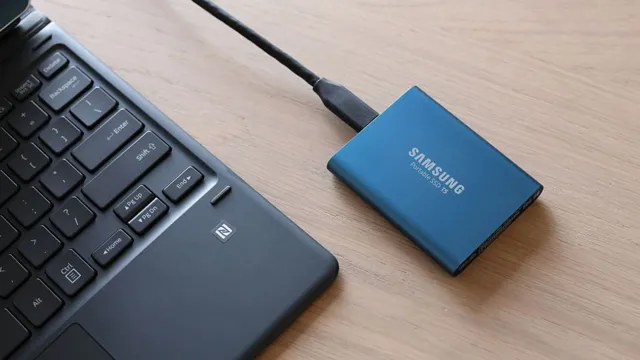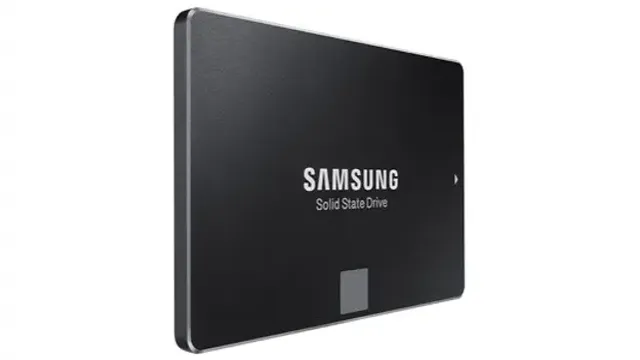Welcome to the world of external SSDs! These compact, high-speed storage devices are perfect for people who need to carry their files around with them or want to quickly and easily transfer data between computers. But how do you connect an external SSD to your PC? It’s easier than you might think! First, you’ll need to check your computer’s ports to see what kind of connector you need. Many newer laptops and desktops have USB-C ports, which provide high-speed data transfer and power delivery in one compact connector.
If your computer doesn’t have a USB-C port, don’t worry – most external SSDs come with a USB-A adapter, which will allow you to connect it to a standard USB port. Once you know what kind of connector you need, simply plug the external SSD into your computer and wait for it to be recognized. Depending on your operating system, you may need to install drivers or manually mount the drive before you can access it.
But once you’re up and running, you’ll be able to store and access your files with lightning-fast speed. Overall, connecting an external SSD to your PC is a straightforward process that anyone can do. Whether you’re a professional on the go or a home user looking for a quick and easy way to back up your files, external SSDs are a great choice for fast, reliable storage.
So why not give one a try?
Types of Connections
External SSDs connect to PCs through various types of connections, including USB-A, USB-C, Thunderbolt, and eSATA. The USB-A connection is the most common and widely used type of connection, as it is compatible with almost all computers. USB-C is the newest and fastest connection available, providing better performance with compatible systems.
Thunderbolt connections provide the highest transfer speeds, making them ideal for professional users who require quick data transfers. Finally, eSATA connections offer faster transfer speeds and higher throughput compared to USB connections, making them a great option for data-intensive workloads. When connecting an external SSD to your PC, it’s important to choose the right type of connection to ensure maximum performance and compatibility.
USB Connection and Type-C
When it comes to USB connections, there are several types to keep in mind. The most common type is a Type-A USB, which is the standard rectangular connector that plugs into computers and chargers. Another common type is a Type-B USB, which is a square connector often found on printers and external hard drives.
In recent years, however, the Type-C USB connector has gained popularity. The Type-C connector is a small, reversible connector that can carry power, data, and video. It is becoming the new standard for many devices, including laptops, smartphones, and tablets.
The advantage of the Type-C connector is that it can transfer data and charge devices at faster speeds than previous types. Plus, its reversible design makes it easy to plug in without fiddling around. With more and more devices making the switch to Type-C connectors, it’s worth investing in some cables that are compatible with this type of connection.

Thunderbolt Connection
When it comes to Thunderbolt connections, there are a few different types to be aware of. The original Thunderbolt connection, now referred to as Thunderbolt 1, is capable of transferring data at speeds of up to 10Gbps. Thunderbolt 2 was then released and doubled the speed to 20Gbps.
The latest version, Thunderbolt 3, offers even faster speeds of up to 40Gbps. Not only do these connections offer lightning-fast data transfer speeds, but they also allow for the use of multiple displays, devices, and power delivery. Thunderbolt 3 even supports USB-C, making it even more versatile.
No matter which version of Thunderbolt you choose, you can be sure that your data will transfer rapidly and conveniently.
Connecting and Setting up an External SSD
Connecting an external SSD to a PC is a simple process that can be done in a matter of minutes. First, check the type of ports your PC has as this will determine the cable needed to connect your SSD. Most external SSDs use USB
0 or 1, which are the most common interfaces on modern computers. Once you have the correct cable, connect one end to your SSD and the other end to your PC.
You may need to follow some prompts on your computer to ensure the SSD is recognized, and you may want to format the drive before use. Once you’ve done this, you’re ready to transfer your files and start using your external SSD! So, don’t let the fear of setting up an external SSD stop you from experiencing faster read/write speeds and increased storage capacity.
Step-by-step Guide for USB Connection
Connecting an external SSD to your computer through a USB connection is a straightforward process that can be done within a few minutes. To get started, connect the USB cable to your computer and to the SSD drive. Once the connection is made, your computer will detect the new device and prompt you to install the necessary drivers.
This can take a couple of minutes, but once the drivers are installed, your external SSD will appear in your file explorer as a new drive. You can then transfer data to and from the drive just like you would with any other storage device. It’s important to ensure that both the USB cable and SSD drive are compatible with each other to avoid any connectivity issues.
So, follow the manufacturer’s instructions and make sure that your computer has the necessary ports to connect the drive. With these simple steps, you can easily set up and use your external SSD for all your storage needs.
Step-by-step Guide for Thunderbolt Connection
Thunderbolt Connection Connecting an external SSD through Thunderbolt is a great way to transfer large amounts of data in a short amount of time. The first step is to check if your computer has a Thunderbolt port. If it does, then you can purchase a Thunderbolt cable.
Once you have the cable, connect one end to your computer’s Thunderbolt port and the other end to your SSD’s Thunderbolt port. After that, turn on the SSD and check if it appears on your computer. If it does not, you may need to format the SSD by going to “Disk Utility” on your computer.
Format the SSD and voila! You can easily transfer data between your computer and external SSD. Note that Thunderbolt cables come in two versions, Thunderbolt 2, and Thunderbolt Make sure you select the right one that is compatible with your computer.
Overall, connecting and setting up an external SSD through Thunderbolt is straightforward and easy.
Maintaining and Safely Ejecting External SSD
When it comes to connecting an external SSD to your PC, the process is relatively simple. Most modern computers come equipped with USB or Thunderbolt ports, both of which can be used to link up an external SSD. Simply plug the SSD into the port and wait for your PC to recognize the device.
From there, you can transfer files and folders back and forth freely. However, it’s important to remember that once you’re finished using your external SSD, you’ll need to safely eject it before unplugging it. Failure to do so could result in data corruption or loss.
To safely eject your external SSD, simply right-click on the device icon in your file explorer and select the “eject” option. Wait for the “device safe to remove” notification to appear before unplugging the SSD from your computer. By following these steps, you can ensure that your external SSD remains in good working condition and that your data stays safe.
How to Properly Eject Your External SSD
When it comes to maintaining and safely ejecting your external SSD, there are a few things you need to keep in mind. Firstly, it’s important to regularly clean your SSD to ensure optimal performance. You can do this by using disk cleanup tools or manually deleting unnecessary files.
Secondly, when it’s time to eject your SSD, it’s crucial that you do so properly. Simply pulling it out without ejecting it first can cause data corruption and other issues. Instead, make sure to follow the recommended eject procedures for your operating system.
This could involve clicking on the “eject” button, dragging the SSD icon to the trash, or using a specific hotkey. By following these steps, you can ensure that your external SSD stays in good working condition and that your data is always safe.
Tips for Maintaining SSD Connection
Maintaining an external SSD connection is essential to prolonging the lifespan of your device. Safely ejecting your external SSD is one of the best ways to prevent data loss and damage. To do this, make sure to properly close any open applications or files before ejecting your device.
Simply unplugging your SSD without following the proper procedures can lead to damage and data corruption. Additionally, you should avoid moving your device while it is in use as this can also cause data loss or damage. In order to keep your external SSD in top condition, it’s important to clean it periodically and avoid excessive heat and dust.
By following these tips, you’ll be able to maintain a healthy external SSD connection and ensure that your device lasts for years to come.
Benefits of Using an External SSD
If you’re considering using an external SSD, you may be wondering how it connects to your PC. The good news is that it’s easy to connect an external SSD to your computer. Generally, external SSDs use a USB cable to connect to your PC.
You simply plug one end of the USB cable into the external SSD, and the other end into your computer’s USB port. Once connected, your computer will recognize the external SSD as an additional drive. From there, you can transfer data to and from the external SSD just like you would with any other drive.
The benefits of using an external SSD are numerous, including faster speeds, increased storage capacity, and improved file transfer rates. Whether you’re using the external SSD for backup storage or for everyday use, it can help you work more efficiently and effectively.
Conclusion
In conclusion, an external SSD connects to a PC through the wonders of technology and the beauty of simplicity. It’s a match made in digital heaven as the SSD uses a USB cable to plug into the PC’s USB port, allowing for lightning-fast data transfer and providing the user with an efficient and portable storage solution. So, if you’re looking to free up some space on your PC without sacrificing performance, grab yourself an external SSD and let the magic unfold!”
FAQs
What is an external SSD?
An external SSD is a portable storage device that uses flash memory to store data, just like the SSD in your computer.
How does an external SSD connect to the PC?
An external SSD can connect to the PC using a USB cable, Thunderbolt cable, or other compatible ports.
What are the advantages of using an external SSD?
External SSDs are faster, lighter, and more durable than traditional hard drives. They also offer more storage capacity and better performance.
Can an external SSD be used as a boot drive?
Yes, an external SSD can be used as a boot drive, but you need to configure the BIOS settings of your PC to make it the preferred boot drive.
